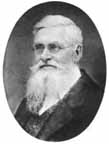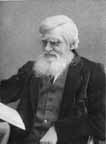The author had graciously shared with readers of the Victorian Web this essay from his rich Alfred Russel Wallace site, which contains extensive bibliographies of primary and secondary materials, a section on frequently asked questions, the complete text of Wallace's most popular works, interviews with the great scientist, obituaries published at the time of his death, and an archive of portraits. Readers interested in Wallace, Darwinism, evolution, and zoology of South East Asia are urged to consult the original.
A. R. Wallace in 1889. Click on thumbnail for a slightly larger image.
With the completion of his great works on biogeography, Wallace turned in earnest to social issues in the 1880s. He had been interested for many years in the problems associated with land tenure, and in 1870, at the special invitation of John Stuart Mill, had even become peripherally involved with the latter's Land Tenure Reform Association. But in early 1881, following the publication of his 'How to Nationalize the Land' (S329), he fully committed himself to the debate by helping start the Land Nationalisation Society. He also became its first President, holding that position until his death, over thirty years later (though after 1895 his participation in the organization's work was more inspirational than actual). Wallace's two most important writings on land were his Land Nationalisation , published in 1882, and 1883's 'The "Why" and the "How" of Land Nationalisation.' In these he argued that the State should, over the long-term, buy out large land holdings and then institute an elaborate rent system based on a combination of location-specific and value-added-by-renter considerations. Wallace's writings on land nationalization include many ideas in advance of their time, including suggestions for the legislated protection of rural lands and historical monuments, the construction of greenbelts and parks, and arguments for suburban and rural re-population and organization. In the early 1880s he also became interested in the anti-vaccination movement. As one of its most powerful spokespersons he would produce a series of impassioned writings that featured statistical epidemiological arguments, a great novelty for its time.Wallace also took up the causes of the labor movement. He was an early proponent of overtime pay rates, but was against strikes: instead, he argued, employees should donate a portion of their pay to funds that could later be used to effect company buy-outs. Eventually he came around to endorsing socialism, but only as late as 1890, on his reading of the American Edward Bellamy's best-selling utopian novel Looking Backward. As mentioned earlier, Wallace had since his early teen years had a genuine love for the work of Robert Owen, but had never quite believed in the large-scale practicality of Owen's approach. Neither had he been quite sure about its possible incursion on individual rights and freedoms. Looking Backward changed his mind on both issues. From 1890 on, Wallace would view socialism as a means whereby the average person might obtain a certain basic and acceptable standard of living; freedom from worrying over basics would then (in theory) allow a re-directioning of attention toward various means of moral/ethical self-improvement (including spiritualism). His motto (borrowed from the English sociologist and writer Benjamin Kidd) would become "Equality of opportunity!", a plea for social justice.
A. R. Wallace in 1902. Click on thumbnail for a larger image.
The preceding list by no means exhausts the range of non-natural science-related subjects that Wallace at one time or another addressed. For example, he was an early supporter of women's suffrage, and was much admired by the members of the women's movement for his unqualified stand on the matter. He also came down heavily on many occasions on societal and governmental responses to eugenics, poverty, militarism, imperialism, and institutional punishment. On several occasions he wrote on the advantages of implementing a paper money standard; his efforts were later recognized by twentieth-century economists interested in currency stabilization theory (the renowned American economist Irving Fisher even dedicated a book to him!). He sparred with the legal system at times, suggesting changes in the means of dealing with inherited wealth and trusts. He wrote two essays on how to re-establish confidence in the House of Lords, and one on how to revitalize the Church of England. Many of the more conservative of the social and institutional elite came to wince at the mere mention of his name.
Although Wallace's travels as a self-supporting naturalist/explorer had ended with his return to England in 1862, he did not lead an entirely sedentary life his remaining years. As already mentioned, he began to move away from London as early as the 1860s; by 1881 he was in Godalming, in 1889, Parkstone, and then, finally, Broadstone (near Wimborne, Dorset, and the English Channel) in 1902. For many years (until 1890) he travelled around the better part of England giving lectures and attending meetings, and even to Scotland and Ireland. He and his wife also spent several vacations and "botanizing excursions" in locations ranging from Wales and the Lake Country to Switzerland. In 1896 he gave an invited lecture on progress in the nineteenth century in the town of Davos in the latter country. But the main adventure of his post-Malay Archipelago life was a ten-month lecture tour to the United States and Canada in 1886 and 1887.

Alfred Russel Wallace's Darwinism. An Exposition of the Theory of Natural Selection with Some of its Applications.
[Click on thumbnail for larger image and additional information.]
In late 1885 Wallace was invited to give a series of lectures on Darwinism at the Lowell Institute in Massachusetts. Once this obligation was met he would be free to arrange such other lectures as he might wish. For six months in late 1886 and early 1887 he stayed mainly in the vicinities of Boston, New York, and Washington, D.C., where he met countless individuals of note, up to and including President Cleveland. In early April of 1887 he set out across the country, reaching California in late May of that year. There he was reunited with his older brother John, who he hadn't seen for nearly forty years. For several weeks he vacationed and lectured; one of his presentations was a talk on spiritualism entitled 'If a Man Die, Shall He Live Again?' --probably the single most successful lecture he ever gave. Significant events from his stay in the San Francisco area included tours of nearby redwood groves (in the company of the eminent naturalist John Muir), Yosemite Valley, and the future site of Stanford University (with Leland Stanford himself, with whom he had become intimate some months earlier in Washington, D.C.). In early July he left California to return eastward, ultimately back to England.
The American tour became the inspiration for Wallace's next major book, in 1889. Titled Darwinism (S724), it consisted largely of the topics he had lectured on, presented one chapter at a time. It did very well, and remains one of his most frequently cited works. Darwinism, while perhaps the highpoint of his later scientific work, was nevertheless only a very small part of it. Although social studies were absorbing more and more of his attention throughout the 1880s and 1890s, he was still left with plenty of time to crank out a steady stream of writings on more scientific subjects. During the 1890s alone he again published a total of over 150 works, dozens of these dealing with evolutionary, biogeographic, and physical geography subjects.
By the turn of the century, Wallace was very probably Britain's best known naturalist. By the end of his life, moreover, he may well have owned (based on evidence gleaned from contemporary sources) one of the world's most recognized names. While simultaneously continuing to publish scores of short works, between the years 1898 and 1910--mostly during his ninth decade--he managed to turn out (i.e., as author and/or editor) well over four thousand pages of monographic writings! His final two books were published in the year of his death, 1913. He remained active into his ninety-first year but slowly weakened in his final months. He died in his sleep at Broadstone on 7 November 1913; three days later his remains were buried nearby. On 1 November 1915 a medallion bearing his name was placed in Westminster Abbey.
Despite Wallace's radical associations and links with spiritualism, he was well honored during his lifetime (and he most likely would have been even more so had he not made it clear early on that he was not particularly interested in receiving honoraria). He was awarded honorary doctorates from the University of Dublin in 1882 and Oxford University in 1889, and important medals from the Royal Society in 1868, 1890 and 1908, the Société de Geographie in 1870, and the Linnean Society in 1892 and 1908. He even received the Order of Merit from the Crown in 1908--quite an honor for such an anti-establishment radical. He became a (reluctant) member of the Royal Society in 1893, and at one time or another had professional affiliations with the Royal Geographical Society, Linnean Society, Zoological Society, Royal Entomological Society, Ethnological Society (though apparently not as a member), British Association for the Advancement of Science, Society for Psychical Research, Batavian Society of Arts and Sciences, British National Association of Spiritualists, Land Nationalisation Society, Anti-Vaccination League, and several lesser organizations.
Physical descriptions of Wallace dwell on his height (as a young man he was six feet one inch tall), long beard (maintained from his days in the Malay Archipelago on), and snow-white hair (starting in his fifties). He had a fundamentally lean build, and as the years passed came to walk with a bit of a stoop. His eyesight was not strong, with the result that his sparkling blue eyes were framed by spectacles for most of his life. He experienced various illnesses and ailments throughout his life, none of which individually seems to have had any great negative effect on his productivity.
As a person Wallace was decent to a fault; he possessed an apparently infinite tolerance for the weaknesses of others (and was surely victimized on a number of occasions as a result), but he was also known for not suffering fools gladly. He thrived on public debate, but was personally modest, shy, and self-effacing. Still, by all accounts he was good company when at ease, and was much in demand as a public speaker. He also had a solid reputation as a writer and reviewer, and for all his "isms" was generally regarded by his peers as one of the period's greatest scientific reasoners.
Related Resources
- The Origins of an Evolutionist (1823-1848)
- Travels in the Amazon and Malay Archipelago (1848-1862)
- Wallace the Evolving Polymath (1862-1880)
- Wallace the Social Radical and "Grand Old Man of Science" (1880-1913)
- Wallace's Accomplishments: A Summary List
- A Wallace Chronology
Last modified 6 November 2000

